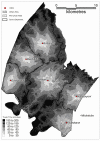Population and antenatal-based HIV prevalence estimates in a high contracepting female population in rural South Africa
- PMID: 17640354
- PMCID: PMC1948890
- DOI: 10.1186/1471-2458-7-160
Population and antenatal-based HIV prevalence estimates in a high contracepting female population in rural South Africa
Abstract
Background: To present and compare population-based and antenatal-care (ANC) sentinel surveillance HIV prevalence estimates among women in a rural South African population where both provision of ANC services and family planning is prevalent and fertility is declining. With a need, in such settings, to understand how to appropriately adjust ANC sentinel surveillance estimates to represent HIV prevalence in general populations, and with evidence of possible biases inherent to both surveillance systems, we explore differences between the two systems. There is particular emphasis on unrepresentative selection of ANC clinics and unrepresentative testing in the population.
Methods: HIV sero-prevalence amongst blood samples collected from women consenting to test during the 2005 annual longitudinal population-based serological survey was compared to anonymous unlinked HIV sero-prevalence amongst women attending antenatal care (ANC) first visits in six clinics (January to May 2005). Both surveillance systems were conducted as part of the Africa Centre Demographic Information System.
Results: Population-based HIV prevalence estimates for all women (25.2%) and pregnant women (23.7%) were significantly lower than that for ANC attendees (37.7%). A large proportion of women attending urban or peri-urban clinics would be predicted to be resident within rural areas. Although overall estimates remained significantly different, presenting and standardising estimates by age and location (clinic for ANC-based estimates and individual-residence for population-based estimates) made some group-specific estimates from the two surveillance systems more predictive of one another.
Conclusion: It is likely that where ANC coverage and contraceptive use is widespread and fertility is low, population-based surveillance under-estimates HIV prevalence due to unrepresentative testing by age, residence and also probably by HIV status, and that ANC sentinel surveillance over-estimates prevalence due to selection bias in terms of age of sexual debut and contraceptive use. The results presented highlight the importance of accounting for unrepresentative testing, particularly by individual residence and age, through system design and statistical analyses.
Figures
Similar articles
-
Reducing uncertainties in global HIV prevalence estimates: the case of Zambia.BMC Public Health. 2006 Apr 2;6:83. doi: 10.1186/1471-2458-6-83. BMC Public Health. 2006. PMID: 16579863 Free PMC article.
-
Studying dynamics of the HIV epidemic: population-based data compared with sentinel surveillance in Zambia.AIDS. 1998 Jul 9;12(10):1227-34. doi: 10.1097/00002030-199810000-00015. AIDS. 1998. PMID: 9677172
-
Overall HIV-1 prevalence in pregnant women over-estimates HIV-1 in the predominantly rural population of Afar Region.Ethiop Med J. 2003 Jun;41 Suppl 1:43-9. Ethiop Med J. 2003. PMID: 15227880
-
[HIV prevalence in sub-Saharan Africa: background of an estimation].Med Sci (Paris). 2009 Jan;25(1):87-92. doi: 10.1051/medsci/200925187. Med Sci (Paris). 2009. PMID: 19154700 Review. French.
-
Measuring trends in prevalence and incidence of HIV infection in countries with generalised epidemics.Sex Transm Infect. 2006 Apr;82 Suppl 1(Suppl 1):i52-6. doi: 10.1136/sti.2005.016428. Sex Transm Infect. 2006. PMID: 16581761 Free PMC article. Review.
Cited by
-
Implications of the HIV testing protocol for refusal bias in seroprevalence surveys.BMC Public Health. 2009 May 28;9:163. doi: 10.1186/1471-2458-9-163. BMC Public Health. 2009. PMID: 19476618 Free PMC article.
-
Dispensing with marriage: Marital and partnership trends in rural KwaZulu-Natal, South Africa 2000-2006.Demogr Res. 2009 Jun 30;20:279-312. doi: 10.4054/DemRes.2009.20.13. Demogr Res. 2009. PMID: 25729322 Free PMC article.
-
Comparison of programmatic data from antenatal clinics with population-based HIV prevalence estimates in the era of universal test and treat in western Kenya.PLoS One. 2023 Jun 26;18(6):e0287626. doi: 10.1371/journal.pone.0287626. eCollection 2023. PLoS One. 2023. PMID: 37363902 Free PMC article.
-
Kaposi's Sarcoma Associated-Herpes Virus (KSHV) Seroprevalence in Pregnant Women in South Africa.Infect Agent Cancer. 2010 Aug 31;5:14. doi: 10.1186/1750-9378-5-14. Infect Agent Cancer. 2010. PMID: 20807396 Free PMC article.
-
High HIV prevalence and associated factors in a remote community in the Rwenzori region of Western Uganda.Infect Dis Rep. 2010 Oct 4;2(2):e13. doi: 10.4081/idr.2010.e13. eCollection 2010 Aug 4. Infect Dis Rep. 2010. PMID: 24470893 Free PMC article. Review.
References
-
- Carpenter L, Nakiyingi J, Ruberantwari A, Malamba SS, Kamali A, Whitworth JAG. Estimates of the impact of HIV infection on fertility in a rural Ugandan population cohort. Health Trans Rev. 1997;7:113–126.
-
- Boerma JT, Urassa M. Associations between female infertility, HIV and sexual behavior in a rural area in Tanzania. In: Boerma JT, Mgalla Z, editor. Women and Infertility in Sub-Saharan Africa: A Multidisciplinary Perspective. Amsterdam, Royal Tropical Institute; 2000. pp. 176–187.
Publication types
MeSH terms
Grants and funding
LinkOut - more resources
Full Text Sources
Medical



